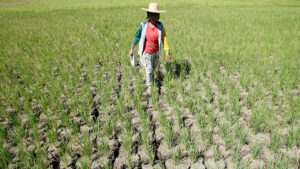AGRICULTURAL damage caused by El Niño has been estimated at P9.5 billion, with rice and corn the most affected crops, according to the Department of Agriculture (DA).
In its 11th El Niño bulletin, the DA said crop damage by volume as of May 16 was 426,798 metric tons across 163,694 hectares of farmland, with 175,063 farmers and fisherfolk affected.
Damage to rice was estimated at P4.6 billion or 48.5% of the total. The volume of rice lost was 185,561 MT spanning 83,862 hectares.
Agriculture Assistant Secretary and Spokesperson Arnel V. de Mesa said damage to the rice crop remained below the DA’s estimates.
“The total area affected is 83,000 (hectares)… Still below is our expected total area of 150,000 hectares to be affected,” he told reporters on Tuesday.
The DA said that 71.22% of the affected farmland was partially damaged, with the remainder suffering total losses.
“Most of the damage and losses involved rice in the reproductive and maturing stages,” it added.
Damage to corn was estimated at 180,807 MT valued at P3.17 billion. This made up 33.42% of total damage brought on by El Niño.
It added that high value crops lost amounted to 49,949 MT across 12,856 hectares of farmland. The losses were valued at P1.65 billion, or 17.36% of the total.
Damage to fisheries was estimated at P57.72 million, affecting 2,261 fisherfolk, while livestock and poultry damage was estimated at P10.47 million.
“Malaking inakyat nito from the last bulletin. Kasi last bulletin 6.3 billion. So ito na siguro ’yung mga huling papasok ng mga report. (Damage estimates have gone up a lot since the last bulletin (which was) P6.3 billion. So these are probably the last reports to come in),” he added.
Mr. De Mesa said that Mimaropa had suffered the most damage with crop losses valued at P2.6 billion.
This was followed by Cagayan Valley with P2.1 billion and the Western Visayas P1.7 billion.
In a May 6 bulletin, the government weather service, known as PAGASA (Philippine Atmospheric, Geophysical and Astronomical Services Administration), said El Niño is weakening and the likelihood of La Niña to occur is 60% between June and August.
The hotter and drier conditions from El Niño are also expected to persist.
On Monday, the DA said that it had begun monitoring prices of farm goods as the climate transitions to La Niña. — Adrian H. Halili
